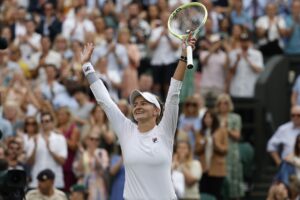Novak Djokovic may have wrapped up a ninth Australian Open triumph in routine fashion, but his path to the title in Melbourne was anything but straightforward. The Serbian world #1 had to battle with an abdomen injury that may have cleared up by the final, but certainly bothered him in at least three of his matches, as well as a new generation of rivals increasingly confident in their abilities to take on and beat the best.
That belief prove to be unfounded, with Djokovic thrashing Daniil Medvedev, a man eight years his junior, 7-5 6-2 6-2 in the final, but what may be most concerning to Medvedev and his contemporaries, is the sort of tennis Djokovic played throughout the fortnight at Melbourne Park. It was not all vintage Djokovic, his tally of five sets lost in seven matches attests to that much, but it was unusually attacking for a man who has long relied principally on his strengths as a counter-puncher.
Indeed, Djokovic ended the tournament having hit 103 aces, 17 clear of his nearest competition in Alexander Zverev, albeit having played two matches more. He was even further ahead of the 6’6” Medvedev, who mustered a comparatively lowly 80 aces over the course of his seven matches in Melbourne. Djokovic also hit his forehand harder than he ever has before in Melbourne and went down the line with that shot more frequently than he has before in his career.
That aggressive intent was certainly partly a reflection of the faster than normal court surface at Melbourne Park, but also bore more than a passing resemblance to the style of tennis deployed so effectively by Roger Federer. That is not entirely surprising, not least because both men have far more in common than is usually assumed. In fact, the central strength of both Djokovic’s and Federer’s game is their peerless ability to time the ball, even if they have used that skill in different ways.
It would, therefore, not be entirely surprising if Djokovic, just as Federer did at a similar age, looks to prolong his career by adopting a more aggressive style of play. Of course, Rafael Nadal, whose game has always been more physically demanding even than Djokovic’s, has moved the needle in terms of what is viewed as athletically possible for a player in their mid-30’s, but it is equally true that Djokovic’s hard-court throne has always rested on shakier foundations than Nadal’s mastery of the clay.
Nadal, at least for now, can continue to trust that his grinding defence will see him rack up titles on the clay, as well as sustain challenges on the slower hard courts. But one senses that Djokovic, who has more than once had the racket taken out of his hands by powerful opponents on the fast hard courts he was once so difficult to beat on, must adapt to survive. It appears that by shifting his focus to the areas of his game that allow him to strike first, he has recognised exactly that.
Djokovic will almost certainly never become an exact replica of the all-court, attacking player that Federer is. There are too many differences in their skillset for that, regardless of their core similarity. But Djokovic, as he displayed in Melbourne, is increasingly confident and capable of playing front-foot tennis, using his serve and forehand to dictate proceedings. And that might just be enough to give him the edge he needs in the race to finish with the most Grand Slam titles in the history of the men’s game.
Main photo:
Embed from Getty Images





